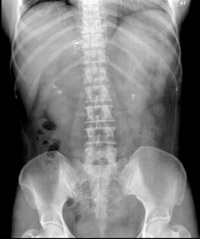问题
问答题 案例分析题
病历摘要:肾结石患者,女性,50岁。腰痛1个月。查体:心、肺(-),腹平软,无压痛,腰部叩击痛。行腰椎正侧位检查。

鉴别诊断有哪些?
答案
参考答案:
1.胆囊结石:中年肥胖女性多见,临床症状与结石的大小.位置以及胆囊管有无梗阻和并发症的轻重等因素有关。X线平片可发现阳性结石,进占全部胆囊结石的10%~20%,表现为右上腹胆囊区域的高密度影,常为环状,侧位片位于脊柱前方。
2.髓质海绵肾:X片主要表现为双肾区多发小结石,数毫米大小,在 * * 区呈从状排列。排泄性尿路造影可见肾小管扩大呈葡萄串样.扇形或花朵样自肾盏向髓质呈放射状排列,多个小结石即包含于此影之中。肾盏可稍扩大。
3.肾钙质沉着症:双肾实质内见多个高密度钙化充填锥体内,呈扇形排列,双肾窦未见分离。
